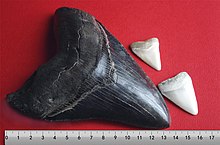HELICOPRION:SHARK OR AMMONITE? Is Helicoprion a shark or an Ammonite? As humans we will ever know, all we can do is imagine. The reason I believe that the Helicoprion tooth spiral isn't a tooth spiral at al is because. All prehistoric shark teeth have cracks in them from being used to kill their prey. But the fossilized teeth have no cracks in it what so ever. And if you were to take a Helicoprion tooth spiral and turn it on its side(see figure 1.1) it would be in the same shape as an Ammonite's shell. The shell would have sharp barbs all over the shell(see figure 1.2) if it really was a Ammonite shell. The barbs would make a great defense against Hybodus the reason(see figure 1.3) I believe Hybodus would be a predator on Ammonites is because it has teeth that look very similar to that of the Bull shark(see figure 1.4) and that is because the Bull shark's teeth are perfect for crushing shells. And to remind you this is only a theory.
| Figure 1.1 |


